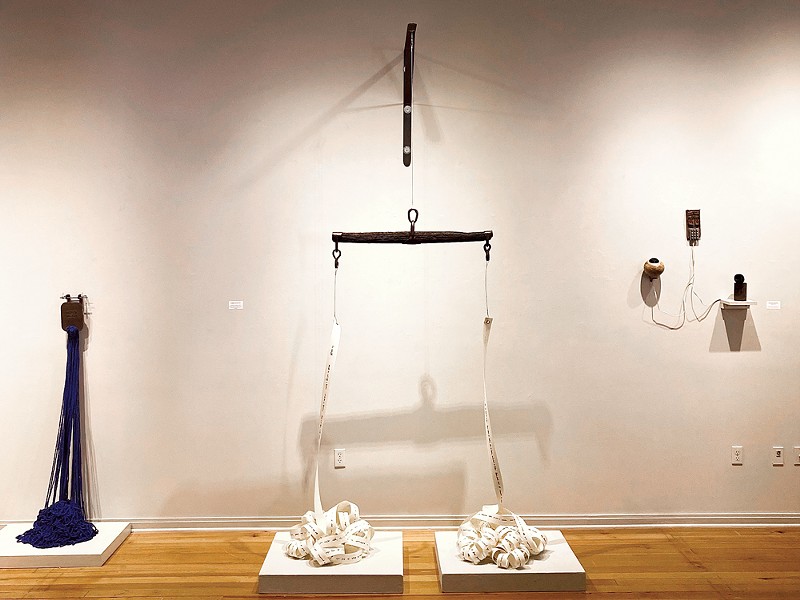Walking into Bernadette Vielbig's ANALOG at the Morris Graves Museum, the wooden yoke suspended along the gallery's back wall doesn't demand immediate attention among the careful arrangement of found-object sculptures. Yet this piece, minimal in its color and construction, embodies several themes of the show, which include reflection on balance, explorations of certain dualities, transformation and repurpose. The yoke, extensively treated and prepped for its second life as a museum-ready art object, dangles at each end long strips of heavy paper tape that drop to the floor in two winding piles. The strips are covered on one side with a single line of the artist's stream of consciousness writing in blue. On one end of the farming implement is writing on wisdom, on the other, weight. The linear text grows into a three-dimensional form, into sculpture, in its heap on the floor, but only bits of the writing are readable. Much is hidden behind other loops and folds in the tape, interrupted and concealed.
It was already November of 2021 when Vielbig got word that she could have the gallery in January of 2022 to install her show, which had been postponed during the pandemic. She says one thing the pandemic taught her is "there is no future," and so she went for it, combining existing pieces with new work produced for the current exhibition. The show then nods toward retrospective or survey, but Vielbig is quick to say it is more a survey of self than of career: "It's a retrospective of 20 years of experiences." Trusting instinct and experience, she chose pieces from her history that are relevant to the conceptual concerns of ANALOG and have relationships to the present moment. According to Vielbig, all the work in the show "speaks to now."
A quintessential Gen X-er, Vielbig ruminates on the transition from analog to digital, which occurred for her in the early phase of her career, and ANALOG invites a question about the relationship between the profound transition of the dawning of the digital age and this present moment in history as a time of transition in the midst of a pandemic. In conversation, Vielbig notes the ambiguous complexities of digitization in the pandemic world — the systemic failures versus our reliance on contemporary technology, like the breakdown of supply lines and the explosion of Zoom conferencing.
Vielbig came to Humboldt the first time around as an undergraduate in the art department at then Humboldt State University, where she earned her BA. She completed her MFA at Louisiana State University and went on to teach around the country. Leaving her tenure at Eastern Spokane Community College in Eastern Washington to return to Humboldt in 2017, she settled in Eureka, where she says she plans to stay.
"As a first-generation American born of naturalized citizen parents," Vielbig says her formative years left an "impression of usefulness in all things deep in [her] psyche." ANALOG displays an investigation of the essence of objects, particularly tools, that may not be useful anymore, at least not for their originally intended purpose. Ancient-looking clothes irons and paper calendars become a new kind of raw material Vielbig combines and recontextualizes to make surprising and often humorous amalgamations, like a vintage telephone and gourd that somehow become animal-like in the gallery.
As with most contemporary found-object art, the work here conveys anxiety about consumption. There is evident unease with the culture of disposability and the work embodies hopeful activity against it, activity in the face of the always increasing speed of obsolesce. There is also reflection on the evolution of objects. In "She Didn't Really like To Press Her Clothes, But Rather Considered it to be a Royal Inconvenience," the viewer can consider the evolution of the iron as metal object that was heated on a stove, into the vintage electric iron, into the current models that inhabit our closets today. The whole of the exhibition traces the evolutions of specific objects from tools to trash to art.
Among the repurposed objects, there are a few artworks that have been constructed. "Family Portrait" is partially comprised of piles of seemingly used and dirty bars of different brands of soap. The gallery signage, however, reveals the soap is actually slip-cast porcelain coated with black iron oxide. Vielbig explains she rubbed off the iron oxide by hand while thinking of a specific family member. Each soap pile corresponds to a member of her immediate family, the type of soap correlating to each personality.
Several works have amusing reveals or visual one-liners, like a cane with an upside-down head of a hammer for the base, and the playfulness of these choices break up the show's conceptualism and formalism. It is the formal considerations, though, that unify the show. The use of line is especially notable. In context, the strong lines of metal, thread, tape and cord constantly refer back to wires. In our digital world, the term "wireless" demonstrates how the wire stays at the center even when it's absent. ANALOG suggests following threads, lines, lines of thought, connections.
The lines of thought evident in Vielbig's sculptures lead to the material nature of the analog era, like the weight of a cassette tape against the weight of an mp3. In either case, it's the information that's always mattered, but where does that information — the intelligence — live? Its home is not on a bookshelf in plastic cases anymore. Veilbig's work plays with the meanings of objects left over when their information is no longer relevant. It asks, what is the content of the physical shell left behind? Where is the wisdom now and what do we do with the weight?
Bernadette Vielbig's ANALOG runs through March 20 at the Morris Graves Museum of Art (636 F St., Eureka), open Wednesday through Sunday from noon to 5 p.m.
L.L. Kessner (she/her) is an Arcata-based artist and writer.



Comments